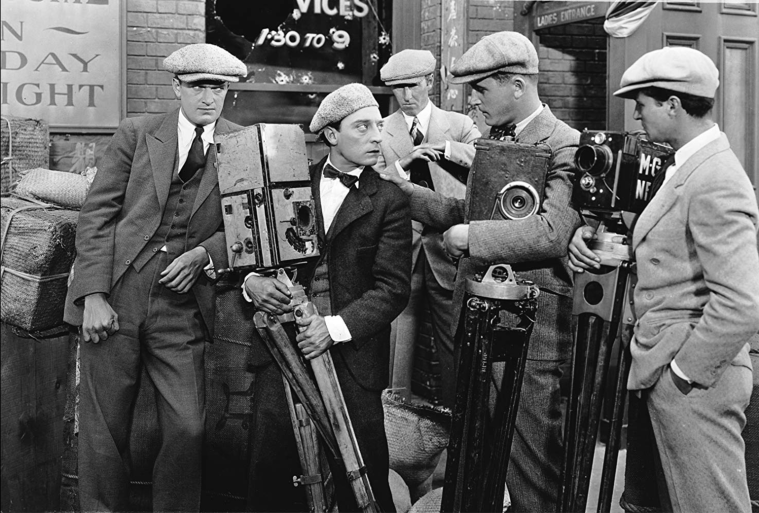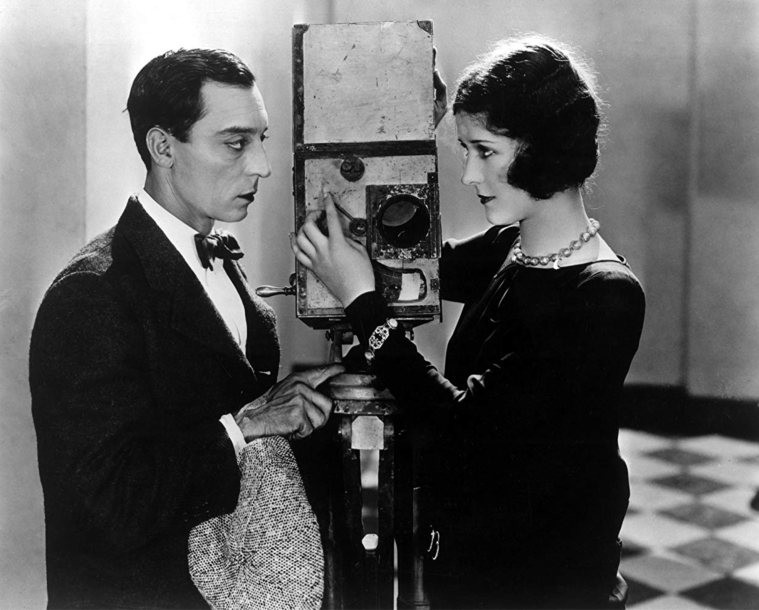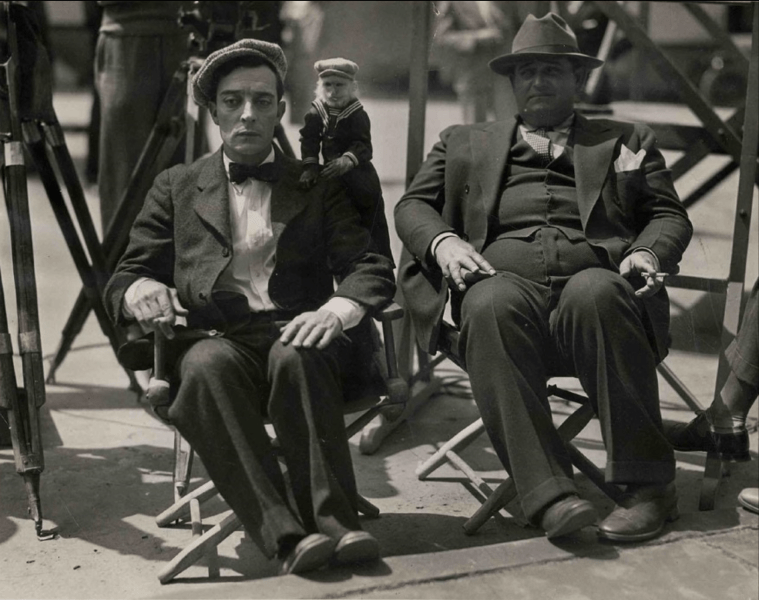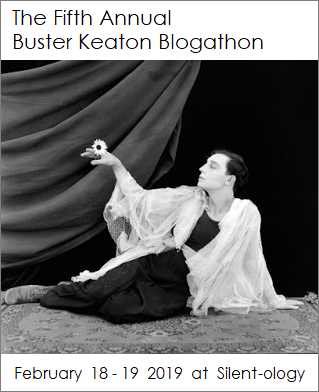
Buster Keaton (centre) and his second-hand movie camera. Image: IMDb
A graphic designer we know had a client who refused all her best ideas. They chopped away at her designs until they looked, well, awful.
“They took a piece of my soul,” she said wrily.
We wondered about miserable work experiences when we watched the Buster Keaton film, The Cameraman (1928).
On the surface, it appears to be a vintage Keaton film, and in many ways it is. Keaton stars as a New York sidewalk tintype photographer who joins the MGM Newsreel Department to impress a woman who works there.
It’s still the same lovable Buster Keaton character: His tintype photographer is woefully out of step with the Modern World of the 1920s. Although tintype photography is gaining a bit of traction now, it hasn’t been really popular since the 1860s and 1870s.
In order to join the Newsreel Team, he trades his tintype gear for a second-hand movie camera. Keaton’s equipment is cheap and inferior, unlike the high-tech models the other cameramen have, and the newsreel boss doesn’t give him any assignments.
However, Keaton’s character gets a Lucky Break and becomes a hero in the end. We knew he had it in him all along.
So why does The Cameraman feel a bit off? Why is it good and disappointing at the same time?

Marceline Day explains how a movie camera works. Image: IMDb
Now, you may think we’re unfair, and perhaps we are. Many people say The Cameraman is as good as Keaton’s previous films.
It is entertaining, but you can tell it was orchestrated by someone else, in this case, MGM Studios.
This was the first film Keaton made at the studio; before this he was an independent filmmaker. It was his business partner and independent film producer, Joseph M. Schenck, who advised Keaton to move to MGM due to financial pressures. Later Keaton said Schenck “never steered me wrong in his life until then. I do not think he meant to that time, either. … In the end I gave in.”¹
Charlie Chaplin advised him Not To Do It, but, no matter how famous you are, bills gotta be paid.
MGM was the antithesis of the Buster Keaton movie-making style. The studio had specific departments for specific roles, and there was No Deviation. Keaton’s approach was more chaotic and improvisational.
However, in MGM’s defence, the studio had the same business model as all major Hollywood studios. Signing a contract with any of them would likely produce the same results.
The premise of The Cameraman was MGM’s idea, allegedly meant to impress newspaper magnate (and MGM stockholder) William Randolph Hearst. They assigned studio crews, writers and a director, although Keaton wasn’t entirely Shut Out of the process. The studio also – and somewhat understandably – outlawed the dangerous stunts for which Keaton was known.
It’s great to have the resources of a big studio, but Keaton’s daring and cleverness is largely absent in this film. Instead we have half-hearted gags (Keaton slips on a banana peel – seriously? Was part of the scene removed?). The man himself looks a bit rough, likely due to personal issues.
Or like someone had taken a piece of his soul.

Keaton on set with co-director Edward Sedgwick. Image: IMDb
The problem is, Keaton was a gifted filmmaker who treated audiences to inventive and ingenious films, such as The General (1926), Sherlock Jr. (1924), and Go West (1925). There was no way a team of studio professionals could duplicate Keaton’s magic.
But MGM came close, very close. The Cameraman is a wonderful film, and his next feature, Spite Marriage (1929), is even better. These two films would be the last of Keaton’s silents, until he made The Railrodder (1965.)
Even so, it was a bad marriage between Keaton and MGM, and he was fired in 1933. He said his studio experience was “the worst mistake of my life”.²
We heartily recommend The Cameraman. However, watching it is bittersweet because Buster Keaton was already a man in decline, his most prolific filmmaking days soon to be behind him.
Sources
¹San Francisco Silent Film Festival. (Retrieved February 7, 2019.) The Cameraman, by Dennis Harvey.
²Ibid.
This post is part of the FIFTH ANNUAL BUSTER KEATON BLOGATHON hosted by Silent-ology.
The Cameraman: starring Buster Keaton, Marceline Day, Harold Goodwin. Directed by Edward Sedgwick (& Buster Keaton). Written by Clyde Bruckman & Lew Lipton. Metro-Goldwyn-Mayer, 1928, B&W, 69 mins.













Should never have signed with them. Going there he lost all his creative control. Why couldn’t they see his talent and just leave him alone to make the films how he saw fit? Such a shame.
LikeLiked by 3 people
I hear you. Surely MGM knew what they were getting and how he worked? If only…
LikeLiked by 2 people
Hi. Haven’t seen this movie. I’m a fan of Buster’s though.
He made a silent movie, The Railrodder, in 1965? I’ve never heard of it. Have you seen it?
Bye till next time, Ruth.
Neil
LikeLiked by 2 people
Yup, he made the film in 1965 in conjunction with Canada’s National Film Board, to celebrate the railways in Canada. Some may find it odd, but I love it – maybe because I’m Canadian. I wrote about it a few years ago:
https://www.google.com/amp/s/silverscreenings.org/2014/10/06/stealing-the-scenery-from-buster-keaton/amp/
LikeLiked by 1 person
So much I didn’t know — many thanks! I really must indulge in a Keaton binge at some point: I’ve seen far too few of his movies.
LikeLiked by 2 people
Oh yes! A Keaton Binge Fest is just what the doctor ordered.
LikeLike
It certainly makes one wonder what his career would have been like if he had never signed with MGM. Would he have continued in his brilliance or self-destructed with his own personal problems. Still, I’m so thankful for his work, both in front of and behind the camera.
LikeLiked by 2 people
Good point. The fact that we can still enjoy his work, decades later, is something to be grateful for.
LikeLike
Probably Buster’s best at MGM… the rest, not so much. They tried to fit him in their own mold, and the results weren’t good, especially the early talkies. Sadly, his career never recovered. However, I enjoy the work he did later with AIP, but I’m probably in the minority on that!
LikeLiked by 2 people
I’ve never seen any of his AIP films, so I’ll check into that. Thanks!
It is sad his career never recovered, but I’m glad to see there was a renewed interest in his work late in his life. At least there was that.
LikeLiked by 2 people
Buster worked behind the scenes for them providing gags for all those “Beach Party” epics with Frankie and Annette, and played small comic parts – they’re a lot of fun if you’re a Buster-holic like me!
LikeLiked by 1 person
I haven’t seen either of his studio films, and it sounds like a bitter sweet experience. It can still be a good movie but lacking the signature Keaton stunts and charms would make it feel off, for sure! Sad to think how that must have felt for him 😦
LikeLiked by 2 people
You’re right – the two MGM silents are good films, but I guess a person gets spoiled with all the earlier works. I can’t imagine what a tense (to put it mildly) experience it would be to work for a major studio after being an independent.
LikeLiked by 1 person
Even working behind the camera as I once did, I can tell you it’s a noticeable difference! I can’t even imagine it as an artist.
LikeLiked by 1 person
Ah, poor Buster. While the film is quite wonderful and Buster has great chemistry with both his leading lady and the monkey, it stands out as the beginning of the end, Great post and sorry for mentioning the monkey. I keep sneaking that chimp in Sunset Boulevard into my blogs and I am beginning to think I have a thing about them….
LikeLiked by 2 people
Haha! I thought the monkey was quite the little scene stealer!
LikeLike
I think Keaton’s genius enabled him to work within the studio’s confines and still produce a comedy classic. Your post about this film–which concerns a camera operator–is timely in light of the Academy Awards’ decision to not present the Cinematography Oscar live on its telecast!
LikeLiked by 2 people
So true! I never really thought about the connection with the Oscar awards ceremony this year.
LikeLike
The Cameraman is a brilliant movie, but his career did go downhill after that (I haven’t seen Spite Marriage yet). Alcoholism also contributed to his downfall. Very sad, because I thought he was better than Chaplin (Chaplin allegedly trimmed Keaton’s part in Limelight because he noticed Keaton was stealing the show from him).
LikeLiked by 2 people
Yes, alcohol was a big part of that, sadly, something that helped him get fired by MGM. I didn’t realize Chaplin had reduced his role in Limelight.
LikeLiked by 1 person
I’ve read that Keaton’s role was supposed to be much larger. Anyhow, it was nice to see Chaplin and Keaton share the screen! 🙂
LikeLiked by 1 person
I am, seriously, very grateful that you posted this. THE CAMERAMAN is good but is not one of my all-time Keaton faves, and I’ve been reluctant to admit that for fear of receiving a stoning from hardcore Keaton buffs. You have perfectly summed up the reasons why I’m hesitant about this movie. As I say, it’s good, but already Keaton’s work has the fingerprints of Big-Studio compromise smudged all over it (the over-dramatic happy ending, etc.) It’s too bad that Keaton’s peak Hollywood years had to end this way.
LikeLiked by 2 people
Ha! I like your phrase “fingerprints of Big-Studio compromise” (Exhibit A: melodramatic ending). And I’m so relieved you agree. Whew!
LikeLiked by 1 person
Thanks for sharing your insights about The Cameraman. It’s a charming movie I enjoy very much.
LikeLiked by 2 people
Thanks for your kind words. I was a bit nervous about not whole-heartedly raving about it, but it still is a very fine movie.
LikeLike
It is impressive to see how Buster has been able to pay tribute to cinema and, still, mocking the studios a little bit, even if they wanted to take control over his movie. Unfortunately, it was the end of the silent era and the golden age of Buster… A bit of tragedy in the life of a master of comedies.
As you said, The Cameraman may not be one of his best movies, but it is like the progressive transition from his best years to his worst.
LikeLiked by 2 people
The Cameraman is a remarkable film given Buster’s situation. Happily, he was able to follow that with Spite Marriage, which I think is the better film of the two.
Also, I just wanted to say again how much I enjoyed your review of Our Hospitality. I may drop everything and watch it right now! 🙂
LikeLiked by 1 person
Thank you very much ! I really appreciate it as I’ve not written that much in English for a while, so I’m glad if my post was able to honor a great movie like Our Hospitality !
You also convinced me to watch Spite Marriage, which may be one of the last movies made by Buster in the 1920s that I’ve not seen yet.
LikeLike
Nice post, and I agree. Generally I like The Cameraman, but it always felt a bit “off” to me too. Maybe BK was feeling “off” w/ all the changes, and we are picking up on that.
LikeLiked by 2 people
I think you’re onto something there. There’s something “off” about this film, as you said, and maybe it is BK’s adjusting to the MGM system.
LikeLike
It’s so sad what happened to Buster, both personally and career-wise, after he moved to MGM. While I love The Cameraman, there is something slightly off about it compared to his previous films. At least he got some creative control over it.
LikeLiked by 2 people
That’s true. At least he wasn’t completely shut out of the creative process. I suspect director Edgar Sedgwick helped – in a positive way – with the MGM transition.
LikeLike
I don’t know that much about Buster Keaton, and this was so interesting. It’s too bad he and MGM didn’t mesh well, but it’s not surprising.
LikeLiked by 2 people
It is too bad things didn’t go better at MGM. But at least we have a lot of Buster’s work to appreciate all these decades later.
LikeLiked by 1 person
Great article Ruth! I must admit I love The Cameraman despite everything. But the whole background is a bit sad indeed and MGM unfortunately exploited Keaton. The documentary I wrote about for the the blogahton talks about that in great details.
LikeLiked by 2 people
Your essay sounds really interesting. I’ll be by later to check it out. 🙂
LikeLiked by 1 person
I love THE CAMERAMAN–to me, it feels a little different than his silents but not in a bad way. I like seeing Buster among big-budget settings and fancy cinematography–make me proud that the big studio put that kind of care into his first film with them, even in hindsight of what came later. And the bit of sentiment is welcome too.
Regarding the banana peel scene, I’m wondering if the joke was the ridiculousness of actually slipping on a banana peel, of all things. Maybe it was a meta joke!
Thank you for sharing your thoughts on this film–you’re always a welcome part of the Busterthon!
LikeLiked by 2 people
Thanks, Lea – and thanks for letting me take part.
Re: the banana peel…Maybe it was a meta joke. I was expecting a super-clever Buster Keaton pay-off, I suppose.
The Cameraman is a fine film, and I agree MGM put a lot of effort into it. If you host the blogathon next year, I think I’d choose Spite Marriage, which I really enjoyed.
LikeLiked by 1 person
“Or like someone had taken a piece of his soul.” What a great way to talk about The Cameraman. Compared to anyone else’s work, it is a wonderful movie, but as you say it seems a off. At least it has Josephine the monkey.
LikeLiked by 2 people
Oh yes, Josephine the monkey is so cute! And, like you say, The Cameraman is a good movie, just not the best of Buster’s silent era.
LikeLike
Bittersweet is the perfect word to describe The Cameraman. If we didn’t know that the fall was about to happen, we could enjoy the film as much as Keaton’s previous ones, but knowing that, the film feels bittersweet. However, it still has a few nice gags and Marceline Day is lovely.
Thanks for the kind comment!
Kisses!
Le
LikeLiked by 2 people
Oh yes, Marceline Day is pitch-perfect in this film. I need to see more of her work.
You make a good point about this film. Because we know what’s coming in Buster K’s life, it makes the movie all the more poignant.
LikeLike
The Cameraman is forever on my “to watch” list, and after this review I might have to just go out and get it. I think its important to know the context surrounding a movie (or any creative work); it helps you gain a better understanding of the film itself. I’d be interested to carefully watch this movie, keeping in the back of my mind that its an MGM and not a BK-indie.
LikeLiked by 2 people
Good point you made re: context of a movie. The Cameraman is a fine movie, and MGM did their level best. When I watched it, I thought it was the last of Buster K’s independent films and it seemed odd to me. But knowing it’s an MGM film would make a person more forgiving, I think. At any rate, I hope you enjoy it. 🙂
LikeLike